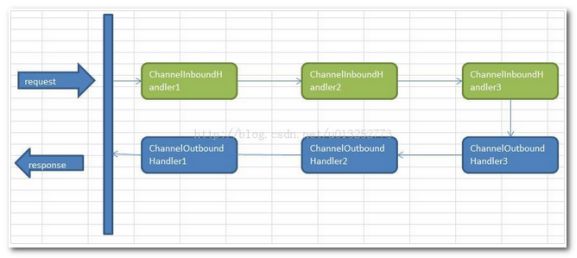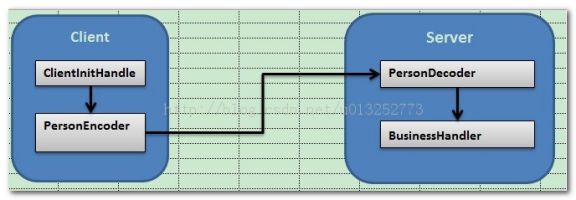netty常用API学习
netty简介
- Netty是基于Java NIO的网络应用框架.
- Netty是一个NIO client-server(客户端服务器)框架,使用Netty可以快速开发网络应用,例如服务器和客户端协议。Netty提供了一种新的方式来使开发网络应用程序,这种新的方式使得它很容易使用和有很强的扩展性。Netty的内部实现时很复杂的,但是Netty提供了简单易用的api从网络处理代码中解耦业务逻辑。Netty是完全基于NIO实现的,所以整个Netty都是异步的。
- 网络应用程序通常需要有较高的可扩展性,无论是Netty还是其他的基于Java NIO的框架,都会提供可扩展性的解决方案。Netty中一个关键组成部分是它的异步特性.
netty的helloworld
下载netty包
- 下载netty包,下载地址http://netty.io/-N/
服务端启动类
import io.netty.bootstrap.ServerBootstrap;
import io.netty.channel.Channel;
import io.netty.channel.ChannelFuture;
import io.netty.channel.ChannelInitializer;
import io.netty.channel.EventLoopGroup;
import io.netty.channel.nio.NioEventLoopGroup;
import io.netty.channel.socket.nio.NioServerSocketChannel;
/**
* • 配置服务器功能,如线程、端口 • 实现服务器处理程序,它包含业务逻辑,决定当有一个请求连接或接收数据时该做什么
*
*/
public class EchoServer {
private final int port;
public EchoServer(int port) {
this.port = port;
}
public void start() throws Exception {
EventLoopGroup eventLoopGroup = null;
try {
//创建ServerBootstrap实例来引导绑定和启动服务器
ServerBootstrap serverBootstrap = new ServerBootstrap();
//创建NioEventLoopGroup对象来处理事件,如接受新连接、接收数据、写数据等等
eventLoopGroup = new NioEventLoopGroup();
//指定通道类型为NioServerSocketChannel,设置InetSocketAddress让服务器监听某个端口已等待客户端连接。
serverBootstrap.group(eventLoopGroup).channel(NioServerSocketChannel.class).localAddress("localhost",port).childHandler(new ChannelInitializer() {
//设置childHandler执行所有的连接请求
@Override
protected void initChannel(Channel ch) throws Exception {
ch.pipeline().addLast(new EchoServerHandler());
}
});
// 最后绑定服务器等待直到绑定完成,调用sync()方法会阻塞直到服务器完成绑定,然后服务器等待通道关闭,因为使用sync(),所以关闭操作也会被阻塞。
ChannelFuture channelFuture = serverBootstrap.bind().sync();
System.out.println("开始监听,端口为:" + channelFuture.channel().localAddress());
channelFuture.channel().closeFuture().sync();
} finally {
eventLoopGroup.shutdownGracefully().sync();
}
}
public static void main(String[] args) throws Exception {
new EchoServer(20000).start();
}
}
服务端回调方法
import io.netty.buffer.ByteBuf;
import io.netty.buffer.Unpooled;
import io.netty.channel.ChannelFutureListener;
import io.netty.channel.ChannelHandlerContext;
import io.netty.channel.ChannelInboundHandlerAdapter;
import java.util.Date;
public class EchoServerHandler extends ChannelInboundHandlerAdapter {
@Override
public void channelRead(ChannelHandlerContext ctx, Object msg)
throws Exception {
System.out.println("server 读取数据……");
//读取数据
ByteBuf buf = (ByteBuf) msg;
byte[] req = new byte[buf.readableBytes()];
buf.readBytes(req);
String body = new String(req, "UTF-8");
System.out.println("接收客户端数据:" + body);
//向客户端写数据
System.out.println("server向client发送数据");
String currentTime = new Date(System.currentTimeMillis()).toString();
ByteBuf resp = Unpooled.copiedBuffer(currentTime.getBytes());
ctx.write(resp);
}
@Override
public void channelReadComplete(ChannelHandlerContext ctx) throws Exception {
System.out.println("server 读取数据完毕..");
ctx.flush();//刷新后才将数据发出到SocketChannel
}
@Override
public void exceptionCaught(ChannelHandlerContext ctx, Throwable cause)
throws Exception {
cause.printStackTrace();
ctx.close();
}
}
客户端启动类
import io.netty.bootstrap.Bootstrap;
import io.netty.channel.ChannelFuture;
import io.netty.channel.ChannelInitializer;
import io.netty.channel.EventLoopGroup;
import io.netty.channel.nio.NioEventLoopGroup;
import io.netty.channel.socket.SocketChannel;
import io.netty.channel.socket.nio.NioSocketChannel;
import java.net.InetSocketAddress;
/**
* • 连接服务器 • 写数据到服务器 • 等待接受服务器返回相同的数据 • 关闭连接
*
*/
public class EchoClient {
private final String host;
private final int port;
public EchoClient(String host, int port) {
this.host = host;
this.port = port;
}
public void start() throws Exception {
EventLoopGroup nioEventLoopGroup = null;
try {
//创建Bootstrap对象用来引导启动客户端
Bootstrap bootstrap = new Bootstrap();
//创建EventLoopGroup对象并设置到Bootstrap中,EventLoopGroup可以理解为是一个线程池,这个线程池用来处理连接、接受数据、发送数据
nioEventLoopGroup = new NioEventLoopGroup();
//创建InetSocketAddress并设置到Bootstrap中,InetSocketAddress是指定连接的服务器地址
bootstrap.group(nioEventLoopGroup).channel(NioSocketChannel.class).remoteAddress(new InetSocketAddress(host, port))
.handler(new ChannelInitializer() {
//添加一个ChannelHandler,客户端成功连接服务器后就会被执行
@Override
protected void initChannel(SocketChannel ch)
throws Exception {
ch.pipeline().addLast(new EchoClientHandler());
}
});
// • 调用Bootstrap.connect()来连接服务器
ChannelFuture f = bootstrap.connect().sync();
// • 最后关闭EventLoopGroup来释放资源
f.channel().closeFuture().sync();
} finally {
nioEventLoopGroup.shutdownGracefully().sync();
}
}
public static void main(String[] args) throws Exception {
new EchoClient("localhost", 20000).start();
}
}
netty中handler的执行顺序
- Handler在netty中,无疑占据着非常重要的地位。Handler与Servlet中的filter很像,通过Handler可以完成通讯报文的解码编码、拦截指定的报文、统一对日志错误进行处理、统一对请求进行计数、控制Handler执行与否。一句话,没有它做不到的只有你想不到的。
- Netty中的所有handler都实现自ChannelHandler接口。按照输出输出来分,分为ChannelInboundHandler、ChannelOutboundHandler两大类。ChannelInboundHandler对从客户端发往服务器的报文进行处理,一般用来执行解码、读取客户端数据、进行业务处理等;ChannelOutboundHandler对从服务器发往客户端的报文进行处理,一般用来进行编码、发送报文到客户端。
- Netty中,可以注册多个handler。ChannelInboundHandler按照注册的先后顺序执行;ChannelOutboundHandler按照注册的先后顺序逆序执行,如下图所示,按照注册的先后顺序对Handler进行排序,request进入Netty后的执行顺序为
代码示例
-
server
import io.netty.bootstrap.ServerBootstrap; import io.netty.channel.Channel; import io.netty.channel.ChannelFuture; import io.netty.channel.ChannelInitializer; import io.netty.channel.EventLoopGroup; import io.netty.channel.nio.NioEventLoopGroup; import io.netty.channel.socket.nio.NioServerSocketChannel; /** * • 配置服务器功能,如线程、端口 • 实现服务器处理程序,它包含业务逻辑,决定当有一个请求连接或接收数据时该做什么 */ public class EchoServer { private final int port; public EchoServer(int port) { this.port = port; } public void start() throws Exception { EventLoopGroup eventLoopGroup = null; try { //server端引导类 ServerBootstrap serverBootstrap = new ServerBootstrap(); //连接池处理数据 eventLoopGroup = new NioEventLoopGroup(); serverBootstrap.group(eventLoopGroup) .channel(NioServerSocketChannel.class)//指定通道类型为NioServerSocketChannel,一种异步模式,OIO阻塞模式为OioServerSocketChannel .localAddress("localhost",port)//设置InetSocketAddress让服务器监听某个端口已等待客户端连接。 .childHandler(new ChannelInitializer() {//设置childHandler执行所有的连接请求 @Override protected void initChannel(Channel ch) throws Exception { // 注册两个InboundHandler,执行顺序为注册顺序,所以应该是InboundHandler1 InboundHandler2 // 注册两个OutboundHandler,执行顺序为注册顺序的逆序,所以应该是OutboundHandler2 OutboundHandler1 ch.pipeline().addLast(new EchoInHandler1()); ch.pipeline().addLast(new EchoInHandler2()); ch.pipeline().addLast(new EchoOutHandler1()); ch.pipeline().addLast(new EchoOutHandler2()); } }); // 最后绑定服务器等待直到绑定完成,调用sync()方法会阻塞直到服务器完成绑定,然后服务器等待通道关闭,因为使用sync(),所以关闭操作也会被阻塞。 ChannelFuture channelFuture = serverBootstrap.bind().sync(); System.out.println("开始监听,端口为:" + channelFuture.channel().localAddress()); channelFuture.channel().closeFuture().sync(); } finally { eventLoopGroup.shutdownGracefully().sync(); } } public static void main(String[] args) throws Exception { new EchoServer(20000).start(); } }
-
EchoInHandler1
-
public class EchoInHandler1 extends ChannelInboundHandlerAdapter { @Override public void channelRead(ChannelHandlerContext ctx, Object msg) throws Exception { System.out.println("in1"); // 通知执行下一个InboundHandler ctx.fireChannelRead(msg); } @Override public void channelReadComplete(ChannelHandlerContext ctx) throws Exception { ctx.flush();//刷新后才将数据发出到SocketChannel } @Override public void exceptionCaught(ChannelHandlerContext ctx, Throwable cause) throws Exception { cause.printStackTrace(); ctx.close(); } }
-
-
EchoInHandler2
-
import io.netty.buffer.ByteBuf; import io.netty.buffer.Unpooled; import io.netty.channel.ChannelHandlerContext; import io.netty.channel.ChannelInboundHandlerAdapter; import java.util.Date; import cn.itcast_03_netty.sendobject.bean.Person; public class EchoInHandler2 extends ChannelInboundHandlerAdapter { @Override public void channelRead(ChannelHandlerContext ctx, Object msg) throws Exception { System.out.println("in2"); ByteBuf buf = (ByteBuf) msg; byte[] req = new byte[buf.readableBytes()]; buf.readBytes(req); String body = new String(req, "UTF-8"); System.out.println("接收客户端数据:" + body); //向客户端写数据 System.out.println("server向client发送数据"); String currentTime = new Date(System.currentTimeMillis()).toString(); ByteBuf resp = Unpooled.copiedBuffer(currentTime.getBytes()); ctx.write(resp); } @Override public void channelReadComplete(ChannelHandlerContext ctx) throws Exception { ctx.flush();//刷新后才将数据发出到SocketChannel } @Override public void exceptionCaught(ChannelHandlerContext ctx, Throwable cause) throws Exception { cause.printStackTrace(); ctx.close(); } }
-
-
EchoOutHandler1
-
import java.util.Date; import io.netty.buffer.ByteBuf; import io.netty.buffer.Unpooled; import io.netty.channel.ChannelHandlerContext; import io.netty.channel.ChannelOutboundHandlerAdapter; import io.netty.channel.ChannelPromise; public class EchoOutHandler1 extends ChannelOutboundHandlerAdapter { @Override // 向client发送消息 public void write(ChannelHandlerContext ctx, Object msg, ChannelPromise promise) throws Exception { System.out.println("out1"); /*System.out.println(msg);*/ String currentTime = new Date(System.currentTimeMillis()).toString(); ByteBuf resp = Unpooled.copiedBuffer(currentTime.getBytes()); ctx.write(resp); ctx.flush(); } }
-
-
EchoOutHandler2
-
import io.netty.channel.ChannelHandlerContext; import io.netty.channel.ChannelOutboundHandlerAdapter; import io.netty.channel.ChannelPromise; public class EchoOutHandler2 extends ChannelOutboundHandlerAdapter { @Override public void write(ChannelHandlerContext ctx, Object msg, ChannelPromise promise) throws Exception { System.out.println("out2"); // 执行下一个OutboundHandler /*System.out.println("at first..msg = "+msg); msg = "hi newed in out2";*/ super.write(ctx, msg, promise); } }
-
总结
- 在使用Handler的过程中,需要注意:
- ChannelInboundHandler之间的传递,通过调用
ctx.fireChannelRead(msg)实现;调用ctx.write(msg)将传递到ChannelOutboundHandler。 -
ctx.write()方法执行后,需要调用flush()方法才能令它立即执行。 - 流水线pipeline中outhandler不能放在最后,否则不生效
- Handler的消费处理放在最后一个处理。
- ChannelInboundHandler之间的传递,通过调用
netty发送对象
简介
- Netty中,通讯的双方建立连接后,会把数据按照ByteBuf的方式进行传输,例如http协议中,就是通过HttpRequestDecoder对ByteBuf数据流进行处理,转换成http的对象。基于这个思路,我自定义一种通讯协议:Server和客户端直接传输java对象。
- 实现的原理是通过Encoder把java对象转换成ByteBuf流进行传输,通过Decoder把ByteBuf转换成java对象进行处理,处理逻辑如下图所示:
代码
-
bean
import java.io.Serializable; public class Person implements Serializable { private static final long serialVersionUID = 1L; private String name; private String sex; private int age; public String toString() { return "name:" + name + " sex:" + sex + " age:" + age; } get/set... }
-
序列化
import io.netty.buffer.ByteBuf; import io.netty.channel.ChannelHandlerContext; import io.netty.handler.codec.MessageToByteEncoder; import cn.itcast_03_netty.sendobject.bean.Person; import cn.itcast_03_netty.sendobject.utils.ByteObjConverter; /** * 序列化 * 将object转换成Byte[] * */ public class PersonEncoder extends MessageToByteEncoder{ @Override protected void encode(ChannelHandlerContext ctx, Person msg, ByteBuf out) throws Exception { //工具类:将object转换为byte[] byte[] datas = ByteObjConverter.objectToByte(msg); out.writeBytes(datas); ctx.flush(); } }
-
反序列化
import io.netty.buffer.ByteBuf; import io.netty.channel.ChannelHandlerContext; import io.netty.handler.codec.ByteToMessageDecoder; import java.util.List; import cn.itcast_03_netty.sendobject.utils.ByteBufToBytes; import cn.itcast_03_netty.sendobject.utils.ByteObjConverter; /** * 反序列化 * 将Byte[]转换为Object * */ public class PersonDecoder extends ByteToMessageDecoder { @Override protected void decode(ChannelHandlerContext ctx, ByteBuf in, List
-
转换工具类
import io.netty.buffer.ByteBuf; public class ByteBufToBytes { /** * 将ByteBuf转换为byte[] * @param datas * @return */ public byte[] read(ByteBuf datas) { byte[] bytes = new byte[datas.readableBytes()];// 创建byte[] datas.readBytes(bytes);// 将ByteBuf转换为byte[] return bytes; } }import java.io.ByteArrayInputStream; import java.io.ByteArrayOutputStream; import java.io.IOException; import java.io.ObjectInputStream; import java.io.ObjectOutputStream; public class ByteObjConverter { /** * 使用IO的inputstream流将byte[]转换为object * @param bytes * @return */ public static Object byteToObject(byte[] bytes) { Object obj = null; ByteArrayInputStream bi = new ByteArrayInputStream(bytes); ObjectInputStream oi = null; try { oi = new ObjectInputStream(bi); obj = oi.readObject(); } catch (Exception e) { e.printStackTrace(); } finally { try { bi.close(); } catch (IOException e) { e.printStackTrace(); } try { oi.close(); } catch (IOException e) { e.printStackTrace(); } } return obj; } /** * 使用IO的outputstream流将object转换为byte[] * @param bytes * @return */ public static byte[] objectToByte(Object obj) { byte[] bytes = null; ByteArrayOutputStream bo = new ByteArrayOutputStream(); ObjectOutputStream oo = null; try { oo = new ObjectOutputStream(bo); oo.writeObject(obj); bytes = bo.toByteArray(); } catch (Exception e) { e.printStackTrace(); } finally { try { bo.close(); } catch (IOException e) { e.printStackTrace(); } try { oo.close(); } catch (IOException e) { e.printStackTrace(); } } return bytes; } }
-
ServerHandler
import io.netty.channel.ChannelHandlerContext; import io.netty.channel.ChannelInboundHandlerAdapter; import cn.itcast_03_netty.sendobject.bean.Person; public class EchoServerHandler extends ChannelInboundHandlerAdapter { @Override public void channelRead(ChannelHandlerContext ctx, Object msg) throws Exception { Person person = (Person) msg; System.out.println(person.getName()); System.out.println(person.getAge()); System.out.println(person.getSex()); } @Override public void channelReadComplete(ChannelHandlerContext ctx) throws Exception { System.out.println("server 读取数据完毕.."); ctx.flush();//刷新后才将数据发出到SocketChannel } @Override public void exceptionCaught(ChannelHandlerContext ctx, Throwable cause) throws Exception { cause.printStackTrace(); ctx.close(); } }
-
server
import io.netty.bootstrap.ServerBootstrap; import io.netty.channel.Channel; import io.netty.channel.ChannelFuture; import io.netty.channel.ChannelInitializer; import io.netty.channel.EventLoopGroup; import io.netty.channel.nio.NioEventLoopGroup; import io.netty.channel.socket.nio.NioServerSocketChannel; import cn.itcast_03_netty.sendobject.coder.PersonDecoder; /** * • 配置服务器功能,如线程、端口 • 实现服务器处理程序,它包含业务逻辑,决定当有一个请求连接或接收数据时该做什么 * * */ public class EchoServer { private final int port; public EchoServer(int port) { this.port = port; } public void start() throws Exception { EventLoopGroup eventLoopGroup = null; try { //创建ServerBootstrap实例来引导绑定和启动服务器 ServerBootstrap serverBootstrap = new ServerBootstrap(); //创建NioEventLoopGroup对象来处理事件,如接受新连接、接收数据、写数据等等 eventLoopGroup = new NioEventLoopGroup(); //指定通道类型为NioServerSocketChannel,一种异步模式,OIO阻塞模式为OioServerSocketChannel //设置InetSocketAddress让服务器监听某个端口已等待客户端连接。 serverBootstrap.group(eventLoopGroup).channel(NioServerSocketChannel.class).localAddress("localhost",port) .childHandler(new ChannelInitializer() { //设置childHandler执行所有的连接请求 @Override protected void initChannel(Channel ch) throws Exception { //注册解码的handler ch.pipeline().addLast(new PersonDecoder()); //IN1 反序列化 //添加一个入站的handler到ChannelPipeline ch.pipeline().addLast(new EchoServerHandler()); //IN2 } }); // 最后绑定服务器等待直到绑定完成,调用sync()方法会阻塞直到服务器完成绑定,然后服务器等待通道关闭,因为使用sync(),所以关闭操作也会被阻塞。 ChannelFuture channelFuture = serverBootstrap.bind().sync(); System.out.println("开始监听,端口为:" + channelFuture.channel().localAddress()); channelFuture.channel().closeFuture().sync(); } finally { eventLoopGroup.shutdownGracefully().sync(); } } public static void main(String[] args) throws Exception { new EchoServer(20000).start(); } }
-
clientHandler
import io.netty.buffer.ByteBuf; import io.netty.channel.ChannelHandlerContext; import io.netty.channel.SimpleChannelInboundHandler; import cn.itcast_03_netty.sendobject.bean.Person; public class EchoClientHandler extends SimpleChannelInboundHandler{ // 客户端连接服务器后被调用 @Override public void channelActive(ChannelHandlerContext ctx) throws Exception { Person person = new Person(); person.setName("angelababy"); person.setSex("girl"); person.setAge(18); ctx.write(person); ctx.flush(); } // • 从服务器接收到数据后调用 @Override protected void channelRead0(ChannelHandlerContext ctx, ByteBuf msg) throws Exception { System.out.println("client 读取server数据.."); // 服务端返回消息后 ByteBuf buf = (ByteBuf) msg; byte[] req = new byte[buf.readableBytes()]; buf.readBytes(req); String body = new String(req, "UTF-8"); System.out.println("服务端数据为 :" + body); } // • 发生异常时被调用 @Override public void exceptionCaught(ChannelHandlerContext ctx, Throwable cause) throws Exception { System.out.println("client exceptionCaught.."); // 释放资源 ctx.close(); } }
-
client
import io.netty.bootstrap.Bootstrap; import io.netty.channel.ChannelFuture; import io.netty.channel.ChannelInitializer; import io.netty.channel.EventLoopGroup; import io.netty.channel.nio.NioEventLoopGroup; import io.netty.channel.socket.SocketChannel; import io.netty.channel.socket.nio.NioSocketChannel; import java.net.InetSocketAddress; import cn.itcast_03_netty.sendobject.coder.PersonEncoder; /** * • 连接服务器 • 写数据到服务器 • 等待接受服务器返回相同的数据 • 关闭连接 * */ public class EchoClient { private final String host; private final int port; public EchoClient(String host, int port) { this.host = host; this.port = port; } public void start() throws Exception { EventLoopGroup nioEventLoopGroup = null; try { // 创建Bootstrap对象用来引导启动客户端 Bootstrap bootstrap = new Bootstrap(); // 创建EventLoopGroup对象并设置到Bootstrap中,EventLoopGroup可以理解为是一个线程池,这个线程池用来处理连接、接受数据、发送数据 nioEventLoopGroup = new NioEventLoopGroup(); // 创建InetSocketAddress并设置到Bootstrap中,InetSocketAddress是指定连接的服务器地址 bootstrap.group(nioEventLoopGroup)// .channel(NioSocketChannel.class)// .remoteAddress(new InetSocketAddress(host, port))// .handler(new ChannelInitializer() {// // 添加一个ChannelHandler,客户端成功连接服务器后就会被执行 @Override protected void initChannel(SocketChannel ch) throws Exception { // 注册编码的handler ch.pipeline().addLast(new PersonEncoder()); //out //注册处理消息的handler ch.pipeline().addLast(new EchoClientHandler()); //in } }); // • 调用Bootstrap.connect()来连接服务器 ChannelFuture f = bootstrap.connect().sync(); // • 最后关闭EventLoopGroup来释放资源 f.channel().closeFuture().sync(); } finally { nioEventLoopGroup.shutdownGracefully().sync(); } } public static void main(String[] args) throws Exception { new EchoClient("localhost", 20000).start(); } }

